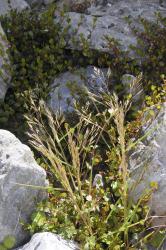- Taxon
- Gallery
- ≡ Agrostis lyallii Hook.f., Bot. Antarct. Voy. II. (Fl. Nov.-Zel.) Part I, 297 (1853)
- ≡ Deyeuxia forsteri var. lyallii (Hook.f.) Hack, Man. New Zealand Fl. 869 (1906) nom. illeg.
- = Deyeuxia forsteri var. semiglabra Hack., Man. New Zealand Fl. 869 (1906) nom. illeg.
- ≡ Lachnagrostis filiformis var. semiglabra (Hack.) Zotov, Rec. Domin. Mus. 5: 142 (1965)
Lax, sometimes stoloniferous, perennial tufts, (5)–10–50 cm, with wide, flat, or narrow and folded, light or dull green leaves, and lax panicles often large in proportion to the plant; branching extravaginal; short plants with narrow involute leaves may be more densely tufted. Leaf-sheath submembranous, distinctly ribbed, smooth, or minutely scabrid above, green to creamy brown, sometimes purplish. Ligule 0.6–4 mm, ovate-oblong, ± truncate, denticulate to later ± lacerate, abaxially minutely scabrid. Leaf-blade 2–15 cm × 0.3–3.5–(6) mm, flat or folded, abaxially smooth to finely scabrid on ribs throughout or near tip, adaxially finely scabrid on ribs; margins minutely scabrid, tip subacute. Culm 3–25–(45) cm, erect or geniculate at base, longer culms projecting beyond uppermost sheaths, internodes usually finely scabrid below panicle. Panicle 4–25 × 1–16 cm, very lax or sometimes contracted after flowering, with widely spreading, finally horizontal branches; branches rather few, very finely, ± sparsely scabrid, with 1–2-several spikelets at branchlet-tips. Spikelets 2.3–4.5–(5) mm, pale green to light straw-coloured, greenish brown or purplish. Glumes subequal, ovate-elliptic or narrowly elliptic-lanceolate, acute, midnerve and hyaline margins scabrid near tip or in upper ½. Lemma (1.5)–2–2.5–(2.8) mm, ½-¾ length of glumes, 5-nerved, with numerous to scattered short fine hairs, sometimes almost completely glabrous, or the upper ⅓ ± glabrous, elliptic-oblong, truncate, lateral nerves slightly to obviously excurrent; awn (1.7)–2–6 mm, geniculate, ± middorsal. Palea c. ½ length to ≈ lemma, keels very faint, 0.1–0.2 mm apart, apex truncate, or obtuse, or shallowly notched. Callus hairs moderately dense, to 1 mm, to ⅓ length of lemma. Rachilla prolongation 0, or up to 1 mm, tipped by a few equally long, or longer hairs. Lodicules 0.7–0.9 mm, linear, acute. Anthers (0.3)–0.6–1.2–(1.5) mm. Caryopsis 1.2–2 × 0.4–0.8 mm. Plate 6B.
[From: Edgar and Connor (2000) Flora of New Zealand. Volume 5 (second printing).]




